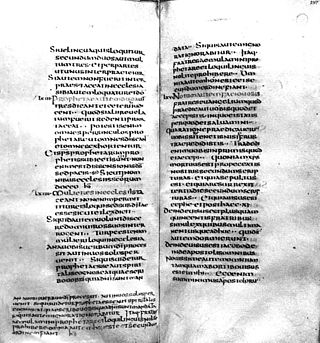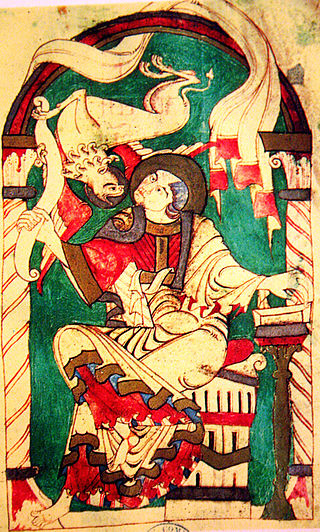The Codex Gatianum, designated by gat or 30 (in Beuron system), is an 8th-century Latin manuscript of the New Testament. The text, written on vellum, is a version of the Old Latin. [1]
The manuscript contains the text of the four Gospels. The Latin text of the Gospels is a representative of the Old Latin version. [1]
Sabatier dated the manuscript to the 7th century, Kilkpatrick to the 8th century. The text was published by Paul Sabatier and J. M. Heer in 1910. It was examined by Heer and Love. [1]
Currently it is housed at the National Library of France (fond lat. 1587) in Paris. [1]

The Vulgate, sometimes referred to as the Latin Vulgate, is a late-4th-century Latin translation of the Bible.

The Peshitta is the standard version of the Bible for churches in the Syriac tradition, including the Maronite Church, the Chaldean Catholic Church, the Syriac Catholic Church, the Syriac Orthodox Church, the Malankara Orthodox Syrian Church, the Malabar Independent Syrian Church, the Syro-Malankara Catholic Church, the Assyrian Church of the East and the Syro-Malabar Church.

The Irish Gospels of St. Gall or Codex Sangallensis 51 is an 8th-century Insular Gospel Book, written either in Ireland or by Irish monks in the Abbey of St. Gall in Switzerland, where it is now in the Abbey library of St. Gallen as MS 51. It has 134 folios. Amongst its eleven illustrated pages are a Crucifixion, a Last Judgement, a Chi Rho monogram page, a carpet page, and Evangelist portraits.

The Codex Alexandrinus, designated by the siglum A or 02, δ 4, is a manuscript of the Greek Bible, written on parchment. Using the study of comparative writing styles (palaeography), it has been dated to the fifth century. It contains the majority of the Greek Old Testament and the Greek New Testament. It is one of the four Great uncial codices. Along with Codex Sinaiticus and Vaticanus, it is one of the earliest and most complete manuscripts of the Bible.

Codex Claromontanus, symbolized by Dp, D2 or 06 (in the Gregory-Aland numbering), δ 1026 (von Soden), is a Greek-Latin diglot uncial manuscript of the New Testament, written in an uncial hand on vellum. The Greek and Latin texts are on facing pages, thus it is a "diglot" manuscript, like Codex Bezae Cantabrigiensis. The Latin text is designated by d (traditional system) or by 75 in Beuron system.

The Codex Fuldensis, also known as the Victor Codex, designated by F, is a New Testament manuscript based on the Latin Vulgate made between 541 and 546. The codex is considered the second most important witness to the Vulgate text; and is also the oldest complete manuscript witness to the order of the Diatessaron. It is an important witness in any discussion about the authenticity of 1 Corinthians 14:34–35 and the Comma Johanneum. It is one of the earliest dated manuscripts of the New Testament. It was corrected until 2 May, 546 AD.
A biblical manuscript is any handwritten copy of a portion of the text of the Bible. Biblical manuscripts vary in size from tiny scrolls containing individual verses of the Jewish scriptures to huge polyglot codices containing both the Hebrew Bible (Tanakh) and the New Testament, as well as extracanonical works.
Codex Colbertinus, designated by 6 or c, is a Latin manuscript of the Bible. Its version of the four Gospels and Book of Acts follows the Vetus Latina, while the rest of the New Testament follows the Vulgate. It was written in the 11th or 12th century, probably in southern France.
The Garland of Howth, also known as the Codex Usserianus Secundus, designated by r2 or 28, is a fragmentary 8th to 10th century Latin Gospel Book now in Trinity College Dublin as MS. 56.

Codex Sangallensis, designated by Δ or 037, ε76, is a Greek-Latin diglot uncial manuscript of the four Gospels. Using the study of comparative writing styles (palaeography), it is usually dated to the 9th century CE, though a few palaeographers would place it in the 10th century CE. It was given its current name by biblical scholar Johann Martin Augustin Scholz in 1830.

Syriac is a dialect of Aramaic. Portions of the Old Testament were written in Aramaic and there are Aramaic phrases in the New Testament. Syriac translations of the New Testament were among the first and date from the 2nd century. The whole Bible was translated by the 5th century. Besides Syriac, there are Bible translations into other Aramaic dialects.

Papyrus 6, designated by 𝔓6 or by ε 021, is a fragmentary early copy of the New Testament in Greek and Coptic (Akhmimic). It is a papyrus manuscript of the Gospel of John that has been dated paleographically to the 4th century. The manuscript also contains text of the First Epistle of Clement, which is treated as a canonical book of the New Testament by the Coptic Church. The major part of the codex is lost.

The Codex Corbeiensis I, designated by ff1 or 9, is an 8th, 9th, or 10th-century Latin New Testament manuscript. The text, written on vellum, is a version of the old Latin. The manuscript contains 39 parchment folios with the text of the four Gospels, Acts of the Apostles, and General epistles.
The Codex Corbeiensis II, designated by ff2 or 8, is a 5th-century Latin Gospel Book. The text, written on vellum, is a version of the old Latin. The manuscript contains 190 parchment folio with the text of the four Gospels with lacunae. Written in a beautiful round uncial hand.
The Codex Sangermanensis I, designated by g1 or 7, is a Latin manuscript, dated AD 822 of portions of the Old Testament and the New Testament. The text, written on vellum, is a version of the Latin. The manuscript contains the Vulgate Bible, on 191 leaves of which, in the New Testament, the Gospel of Matthew contain Old Latin readings. It contains Shepherd of Hermas.
The Codex M. p. th. f. 67, designated by 11A, is an 8th or 9th century Latin Gospel Book. The text, written on vellum, it was known as a manuscript of Vulgate. The manuscript contains the text of the four Gospels on 192 parchment leaves. It is written in two columns per page, 20 lines per column. It contains prolegomena to the Gospels.

The Codex Claromontanus V, designated by h in traditional system or by 12 in the Beuron system, is a 4th or 5th century Latin manuscript of the New Testament. The text, written on vellum.
The Codex Floriacensis, designated by h in traditional system or by 55 in the Beuron system, is a 6th-century Latin manuscript of the New Testament. The text, written on vellum, is a palimpsest. Another name of the manuscript is Fleury Palimpsest or Palimpsestus Floriacensis. It is one of the eight Old-Latin manuscripts with text of Apocalypse.
The Codex Sangermanensis II, designated by g2 or 29, is a 10th-century Latin manuscript of the New Testament. The text, written on vellum, is a version of the Latin.

Vetus Latinamanuscripts are handwritten copies of the earliest Latin translations of the Bible, known as the "Vetus Latina" or "Old Latin". They originated prior to Jerome from multiple translators, and differ from Vulgate manuscripts which follow the late-4th-century Latin translation mainly done by Jerome.